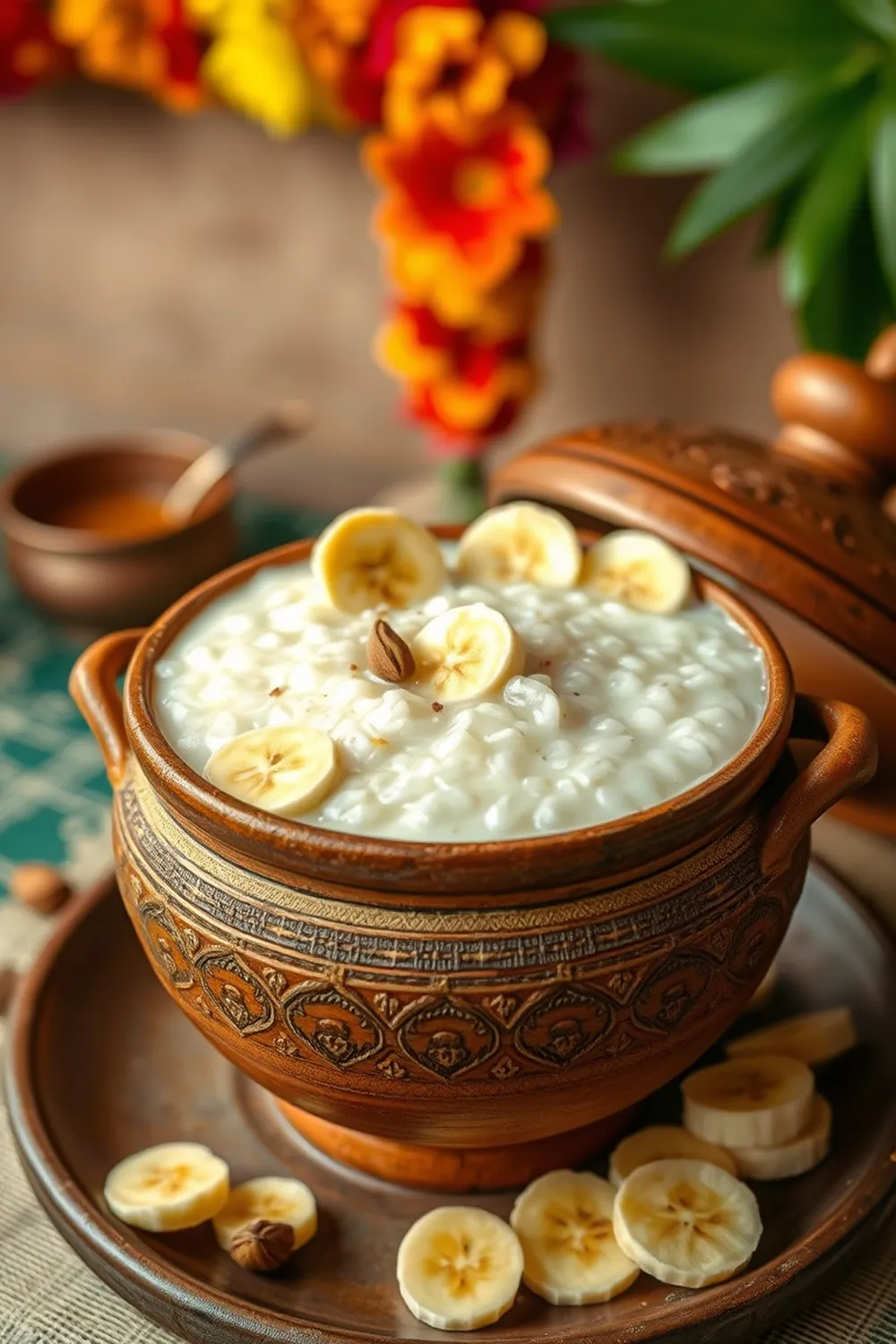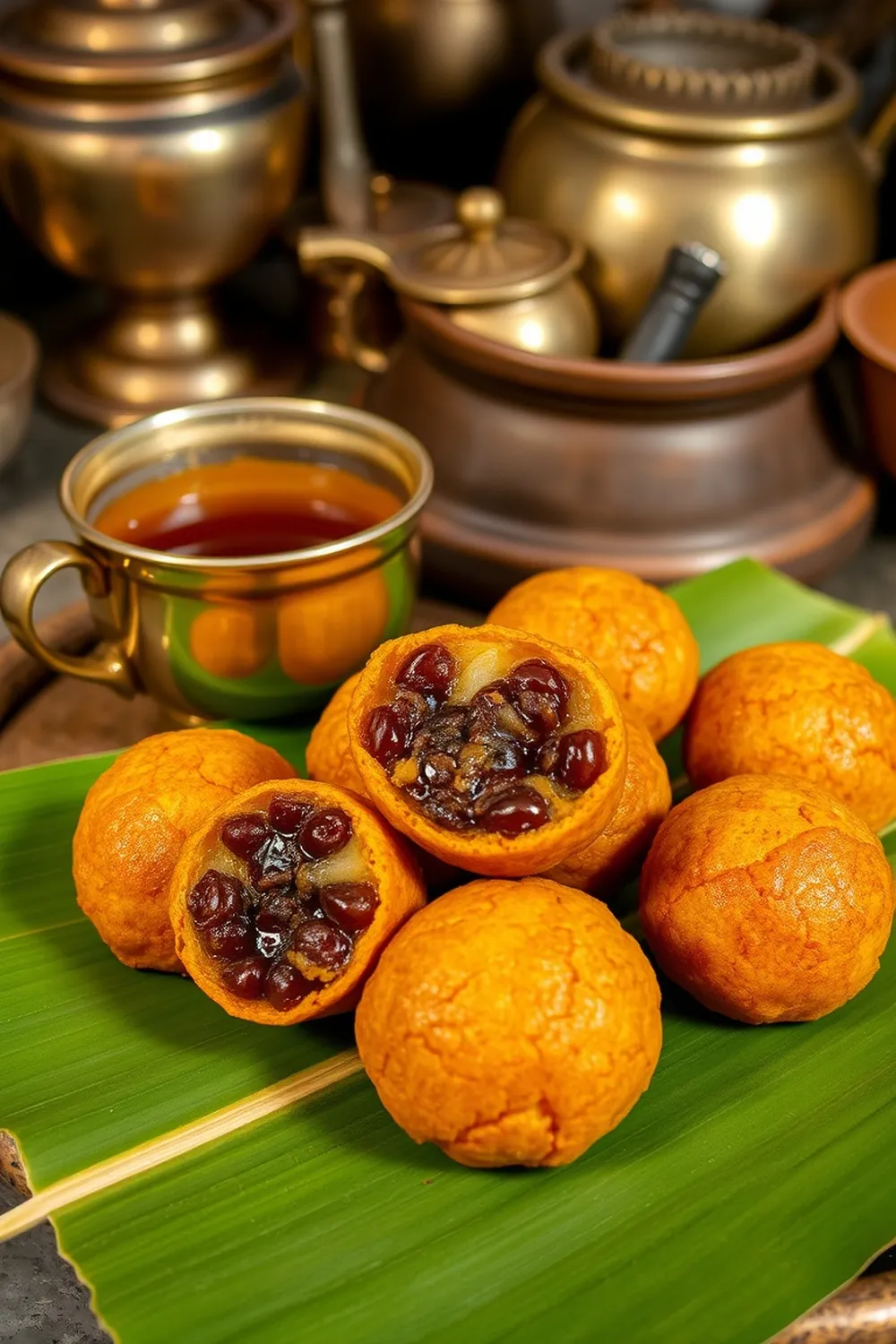- Combine rice flour, jaggery, ghee, and cardamom powder in a mixing bowl.
- Gradually add warm water while mixing to form a smooth, non-sticky dough for Chalimidi.
- Rinse moong dal thoroughly and soak in water for at least 1 hour. Drain completely for Vadapappu.
- Dissolve jaggery in water, then add dry ginger powder, black pepper powder, cardamom powder, lemon juice, and edible camphor for Panakam.
- Strain the Panakam mixture and garnish with fresh tulsi leaves before serving.
- Arrange Chalimidi balls, soaked moong dal, and Panakam in separate serving bowls as ritual offerings.
- Calories:280 kcal25%
- Energy:1171 kJ22%
- Protein:5 g28%
- Carbohydrates:58 mg40%
- Sugar:38 mg8%
- Salt:15 g25%
- Fat:4 g20%
Last Updated on 4 months by Neha Deshmukh
Chalimidi, Vadapappu & Panakam Recipe – Traditional South Indian Ritual Offering
Introduction
Growing up, the aroma of these three dishes – Chalimidi, Vadapappu, and Panakam – always meant something special was brewing. It wasn’t just a snack; it was a connection to our traditions, a part of festivals and prayers. These aren’t everyday treats, but offerings made with love and devotion. I remember helping my grandmother prepare these during special occasions, and now I’m so excited to share these recipes with you! They’re surprisingly simple to make, and the flavors are just divine.
Why You’ll Love This Recipe
This recipe isn’t just about delicious food; it’s about experiencing a piece of South Indian culture. Chalimidi, Vadapappu, and Panakam are traditionally offered during religious ceremonies and festivals, especially during the month of Shravan. They represent purity, prosperity, and devotion. Plus, they’re naturally vegetarian and can easily be adapted to be vegan and gluten-free!
Ingredients
Here’s what you’ll need to create this traditional offering:
- 0.5 cup Idiyappam flour / Homemade processed rice flour
- 0.25 cup Powdered jaggery or powdered sugar
- 0.125 tsp Cardamom powder
- 1 tbsp Ghee
- 0.25 cup Moong dal
- 1 cup Water
- 2 tbsp Powdered jaggery
- 0.25 tsp Dry ginger powder
- 0.25 tsp Pepper powder
- 1 tsp Lemon juice
Ingredient Notes
Let’s talk ingredients! A few little tips can make all the difference.
Idiyappam Flour/Homemade Processed Rice Flour
This is the base for Chalimidi. You can find Idiyappam flour in Indian grocery stores, or you can make your own by soaking, drying, and grinding rice. About 150g of flour is equivalent to ½ cup.
Powdered Jaggery/Powdered Sugar – Regional Variations & Sweetness Levels
Jaggery is traditional and adds a beautiful caramel flavor. But powdered sugar works too! The sweetness level is up to you – adjust to your preference. Around 50g of jaggery is equivalent to ¼ cup.
Cardamom Powder – Quality & Freshness
Freshly ground cardamom is always best. It has a much more potent aroma. If you’re using store-bought, make sure it’s relatively recent.
Ghee – Clarified Butter & Its Significance
Ghee adds richness and a lovely aroma. It’s considered sacred in Hinduism and is often used in religious offerings. About 15ml of ghee is equivalent to 1 tbsp.
Moong Dal – Types & Soaking Importance
Split yellow moong dal is what we’re using here. Soaking it helps it cook faster and become softer.
Water – Quality for Best Results
Filtered water is always a good idea for the best flavor.
Dry Ginger Powder – Health Benefits & Aroma
Dry ginger (sonth) adds a warming spice and is known for its health benefits.
Pepper Powder – Types & Heat Levels
Black pepper is traditional, but you can experiment with white pepper for a milder heat.
Lemon Juice – Fresh vs. Bottled
Freshly squeezed lemon juice is always preferred for its bright flavor.
Step-By-Step Instructions
Let’s get cooking! Don’t worry, it’s easier than it looks.
- Chalimidi: Combine rice flour, jaggery, ghee, and cardamom powder in a mixing bowl. Gradually add water while mixing to form a smooth, non-sticky dough.
- Vadapappu: Rinse moong dal thoroughly and soak in water for 1 hour. Drain completely.
- Panakam: Dissolve jaggery in water, then add dry ginger, pepper, cardamom, and lemon juice.
- Final Touches: Strain the Panakam mixture and garnish with fresh tulsi leaves before serving.
- Offering Time: Arrange the Chalimidi balls, soaked moong dal, and Panakam in separate serving bowls as ritual offerings.
Expert Tips
- Don’t overwork the Chalimidi dough – it should be soft and pliable.
- Make sure the moong dal is completely drained before offering.
- A pinch of edible camphor in the Panakam adds a traditional touch, but it’s optional.
Variations
- Vegan Adaptation: Substitute ghee with coconut oil or any plant-based butter. Use powdered sugar instead of jaggery if you prefer.
- Gluten-Free Confirmation: This recipe is naturally gluten-free, as long as your Idiyappam flour is certified gluten-free.
- Spice Level Adjustment (Pepper): My friend, Priya, loves a little extra kick, so she adds a bit more pepper. Feel free to adjust to your liking!
- Festival Adaptations (Specific Rituals): During some festivals, a small amount of grated coconut is added to the Vadapappu.
Serving Suggestions
These are traditionally offered to deities, but you can also enjoy them as a light and healthy snack. They’re best served at room temperature.
Storage Instructions
Chalimidi and Vadapappu are best made fresh. Panakam can be stored in the refrigerator for up to 24 hours.
FAQs
What is the significance of offering Chalimidi, Vadapappu & Panakam?
These offerings symbolize purity, devotion, and gratitude. They are believed to please the deities and bring blessings.
Can I use regular sugar instead of jaggery? What adjustments should I make?
Yes, you can! Sugar is sweeter than jaggery, so reduce the quantity to about 1.5 tbsp for the Panakam and ¼ cup for the Chalimidi.
How far in advance can I prepare each component (Chalimidi, Vadapappu, Panakam)?
You can soak the moong dal a day in advance. Chalimidi and Panakam are best made on the day of offering.
What is the role of edible camphor in Panakam, and can it be omitted?
Edible camphor is believed to have purifying properties and adds a unique aroma. It can be omitted if you prefer, but it’s a traditional ingredient.
Is there a specific type of moong dal that is traditionally used for Vadapappu?
Split yellow moong dal is the most commonly used type.










